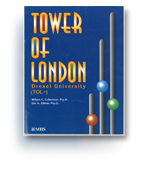 |

d2 Test of Attention
Göttingen, Germany: Hogrefe & Huber, 1998
[more]
............................................
Tower of London - Drexel University (TOL DX)
Chicago, IL: Multi-Health Systems, 2001
|
 |
|
 |
 |
 |
TOWER OF LONDON
Drexel University (TOL DX)

William Culbertson & Eric Zillmer
Chicago, IL: Multi-Health Systems, 2001, 2005
|

Culbertson and Zillmer (1998a, 1998b, 1998c, 2005) designed the Tower of London-Drexel University (TOLDX) as a neuropsychological measure of executive planning and problem solving based on the original Tower of London (Shallice, 1982). The TOLDX measures executive planning that involves the ability to conceptualize change, respond objectively, generate and select alternatives, and sustain attention. The frontal lobes, in systematic interaction with other cortical and subcortical structures, support executive planning. The TOLDX test materials include two identical tower structure, one for the subject and one for the examiner to use. Each structure consists of three pegs of descending lengths and three colored beads that the patient can place on the pegs in different configurations or patterns. The examiner asks the subject to move the beads of his or her tower structure to match bead configurations that the examiner presents. In solving the bead patterns, the subject must adhere to two strictly enforced problem-solving rules: Only move one bead at a time, and don't place more beads than fit on each peg. The examiner records number of moves, rule violations, and time the subject uses in solving the bead patterns. Interpreting the subject's performance involves an analysis of both quantitative and qualitative variables. Empirical studies (Culbertson & Zillmer, 1998a, 1998b, 2005; Culbertson, Zillmer, & Di Pinto, 1999; Zillmer, Culbertson, & Holda, 1997) show that the TOL-Drexel University is sensitive to a complex set of cognitive processes, including planning computations, working memory, mental flexibility, attention allocation, and response inhibition.
The TOLDX consists of a Technical Manual, two tower structures (each with a set of beads) and Record Forms (Child and Adult). The measure presents 10 problems of ascending difficulty that require from 3 to 7 moves to solve. The examinee is asked to match a presented bead configuration while adhering to two specific rules. The TOLDX takes approximately 15 minutes to administer and is well tolerated by examinees due to its brevity, novelty, and game-like appeal. Seven scoring variables, representing different, although overlapping aspects of executive planning and problem solving, are provided. Normative data is available for children and adults ranging in age from 7 to 60+ years. Principles for interpreting the scoring variables, both qualitatively and quantitatively, are outlined for children and adults. Preliminary studies of the psychometric characteristics of the TOLDX are supportive of its reliability and validity. The TOLDX can be obtained from Multi-Health Systems, Inc.
|
|